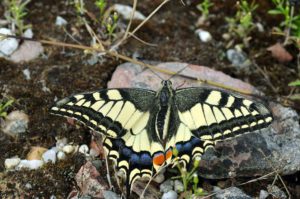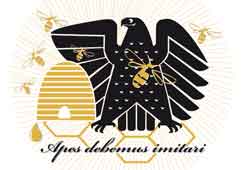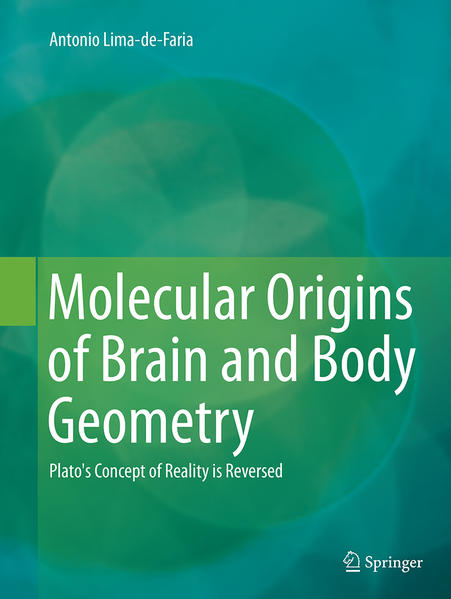- Softcover: 188 Seiten
- Verlag: Springer International Publishing
- Autor: Antonio Lima-de-Faria
- Auflage: 1. Aufl., erschienen am 23.08.2016
- ISBN-10: 3-319-35955-X
- ISBN-13: 978-3-319-35955-7
- Größe und/oder Gewicht: 27,9 x 21,0 cm
Molecular Origins of Brain and Body Geometry
Autoren: Antonio Lima-de-Faria139,99 €

HONIGHÄUSCHEN (BONN) – New concepts arise in science when apparently unrelated fields of knowledge are put together in a coherent way. The recent results in molecular biology allow to explain the emergence of body patterns in animals that before could not be understood by zoologists. There are no fancy curiosities in nature. Every pattern is a product of a molecular cascade originating in genes and a living organism arises from the collaboration of these genes with the outer physical environment. Tropical fishes are as startling in their colors and geometric circles as peacocks. Tortoises are covered with the most regular triangles, squares and concentric circles that can be green, brown or yellow. Parallel scarlet bands are placed side by side of black ones along the body of snakes. Zebras and giraffes have patterns which are lessons in geometry, with their transversal and longitudinal stripes, their circles and other geometric figures. Monkeys, like the mandrills, have a spectacularly colored face scarlet nose with blue parallel flanges and yellow beard. All this geometry turns out to be highly molecular. The genes are many and have been DNA sequenced. Besides they not only deal with the coloration of the body but with the development of the brain and the embryonic process. A precise scenario of molecular events unravels in the vertebrates. It may seem far-fetched, but the search for the origin of this geometry made it mandatory to study the evolution of matter and the origin of the brain. It turned out that matter from its onset is pervaded by geometry and that the brain is also a prisoner of this ordered construction. Moreover, the brain is capable of altering the body geometry and the geometry of the environment changes the brain. Nothing spectacular occurred when the brain arrived in evolution. Not only it came after the eye, which had already established itself long ago, but it had a modest origin. It started from sensory cells on the skin that later aggregated into clusters of neurons that formed ganglia. It also became evident that pigment cells, that decide the establishment of the body pattern, originate from the same cell population as neurons (the neural crest cells). This is a most revealing result because it throws light on the power that the brain has to rapidly redirect the coloration of the body and to change its pattern. Recent experiments demonstrate how the brain changes the body geometry at will and within seconds, an event that could be hardly conceived earlier. Moreover, this change is not accidental it is related to the surrounding environment and is also used as a mating strategy. Chameleons know how to do it as well as flat fishes and octopuses. No one would have dared to think that the brain had its own geometry. How could the external geometry of solids or other figures of our environment be apprehended by neurons if these had no architecture of their own? Astonishing was that the so called simple cells, in the neurons of the primary visual cortex, responded to a bar of light with an axis of orientation that corresponded to the axis of the cells receptive field. We tend to consider our brain a reliable organ. But how reliable is it? From the beginning the brain is obliged to transform reality. Brain imagery involves: form, color, motion and sleep. Unintentionally these results led to unexpected philosophical implications. Platos pivotal concept that forms exist independently of the material world is reversed. Atoms have been considered to be imaginary for 2,000 years but at present they can be photographed, one by one, with electron microscopes. The reason why geometry has led the way in this inquiry is due to the fact that where there is geometry there is utter simplicity coupled to rigorous order that underlies the phenomenon where it is recognized. Order allows variation but imposes at the same time a canalization that is patent in what we call evolution.
Über „Molecular Origins of Brain and Body Geometry“
Das vorliegende Sachbuch zu Themen aus Umwelt und Natur „Molecular Origins of Brain and Body Geometry“ wurde erarbeitet und verfasst von Antonio Lima-de-Faria. Dieses Sachbuch erschien am 23.08.2016 und wurde herausgegeben von Springer International Publishing.
Bücher wie „Molecular Origins of Brain and Body Geometry“ sind im Onlineshop des Honighäuschens bestellbar. Online bestellte Fachbücher zur Imkerei und zu anderen Themen der Umwelt und des Artenschutzes sind zu den üblichen Öffnungszeiten auch direkt im Buchladen Bundesamt für magische Wesen in Bonn, der Stauhauptstadt von Nordrhein-Westfalen abholbar und werden auf Wunsch verschickt.
Das Thema Bienensterben, Rückgang von Insekten und allgemeines Artensterben ist in aller Munde und das Honighäuschen als frühere Bioland Imkerei hat sich von Anfang an daran beteiligt. Mehr als 35 Jahre Imkereierfahrung nahmen ihren Anfang 1982 mit den ersten eigenen Bienen.

Der zehnjährige Junge, der 1977 einem Hamburger Imker über die Schulter schaute; der Fünfzehnjährige, der mit der Imkerei in Zeiten begann, in denen es noch keine Varroamilbe gab; der achtzehnjährige Fahrschüler, der lernte, dass man die Windschutzsscheibe seines Autos nach einer längeren Fahrt von Insekten säubern muß; der zwanzigjährige Student, der für seine Bienen einen Platz in Bonn suchte; der dreißigjährige Berufsimker, der seinen Bienen quasi eine Gutenachtgeschichte erzählte und sich den Kopf zerbrach, wie man die Umwelt mit ihren Bienen, Wespen, Schmetterlingen und andere blütenbesuchenden Insekten vor den Machenschaften der Agrargiftindustrie und der Gleichgültigkeit agrarindustriehöriger Politiker schützt; der Imker, der nicht nur auf dem Weihnachtsmarkt Bonn die Öffentlichkeit suchte, um bei Führungen an den Bienen auf dem Dach der Bundeskunsthalle zu erleben, dass Kinder (und deren Helikoptermuttis!) Angst vor Schmetterlingen hatten, bis hin zum Begleiter von Forschungsprojekten zu den Riesenhonigbienen Nepals oder den Killerbienen Afrikas, stellt fest, dass etwas sehr im Argen liegt in unserem Umgang mit der Umwelt.
Es sollte jedem bewußt sein, dass die Haltung „Natur ja, aber bitte woanders!“ nicht in Ordnung ist.
Die wunderschöne Welt der Natur

In unserem Online-Buchshop finden Sie viele Bücher wie „Molecular Origins of Brain and Body Geometry“, die Ihnen die fantastische Welt der Bienen, Wespen, Ameisen, Hornissen und Schmetterlinge sowie anderer Insekten näherbringen.
Aber nach wie vor stehe ich Ihnen auch gern zu einem Gespräch oder zu einer Beratung im Umgang mit Bienen, Wespen, Hornisse, Wildbienen und Hummeln zur Verfügung, wenn Sie Fragen haben. Besuchen Sie uns in Bonn im Bundesamt für magische Wesen.
Und natürlich gibt es auch weiterhin Honig, Bienenwachskerzen und Met bei uns und zwar das ganze Jahr – nicht nur zu Weihnachten.
| Gewicht | 5093 g |
|---|---|
| Größe | 27,9 × 21 cm |





Bewertungen
Es gibt noch keine Rezensionen